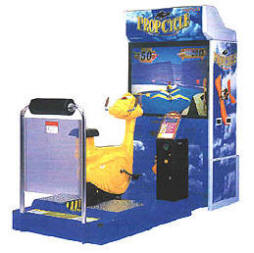Cyclescore on applying exercise to games


MIT's CycleScore has an FAQ:
What's the most unusual thing you've found in your research?Agreed. This is why Prince of Persia is a better overall Kilowatt Sport experience than Grand Turismo. When the Kilowatt folks claim their controller gives you a more nuanced control range, the trouble is that standard games were designed for traditional control pads that don't have that nuance so it's mostly wasted on them. The optimum exercise-game experience requires designing the game and the controller together as a unified whole rather than bolting together mix-and-match parts.We wanted to make use of existing commercial games (rather than design our own), but our research showed that commercial games are too complex. They distract the user and result in sub-optimal workouts. They also have problems with discontinuity (i.e. if you adapt a commercial car game to a bike, what happens when the car in the game crashes? Why are you still pedaling? These kinds of logical discontinuities make adapting commercial games problematic.)
So we had to design games from scratch that would be simple but still fun, and that would motivate the user to push themselves without annoying them....
We've also found that the racing games typically co-opted by most exertainment startups don't work extremely well in the context of exercise. The problem is, the player is too aware of the fact that their pedaling corresponds directly to the speed of their virtual vehicle. They are constantly concerned about pedalling enough to win the race, which sounds good in theory, but in practice, it just leads to a tiring experience. Not super-motivational. We've found that if you disassociate pedaling from speed (and even movement), you're more likely to distract the player, increase motivation, but still create a solid exercise experience.
One of the cooler CycleScore game ideas was to have the user pedal to recharge the weapon rather than to move the ship. Then the game can be tailored to ramp smoothly and require some certain minimum amount of exertion but no more than that; additional effort doesn't help win the game so there's no incentive to pedal yourself silly (and then collapse of exhaustion) trying to get a better score.
Share this:
















